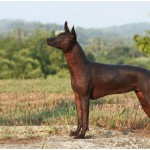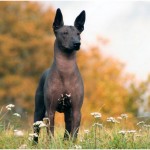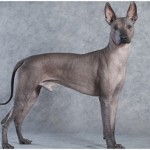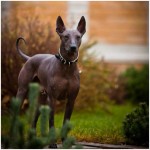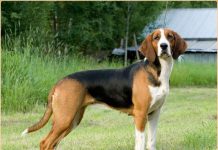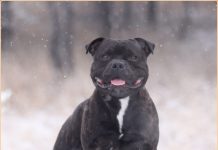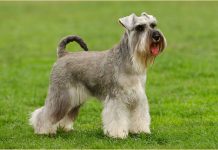The Xoloitzcuintli comes in two varieties, hairless and coated and in three sizes, toy, miniature, and standard. The hairless dog has smooth, sturdy, and tight fitted skin, and the coated one has a short flat coat. The country of origin is Mexico and called with the name Xolo and is famous as a Mexican hairless dog. They are Mexico’s national dog. The pronunciation of Xoloitzcuintli is show-low-eats-queen-tlee.
Xolo is characterized by a lack of hair, teeth abnormalities, and wrinkle head. The 3500 years old Xolo, the ancient Aztec dog of gods, continued to regard as famous healers by some people in Mexico as the heat given off from their body gives comfort to people with arthritis. Today it is a lovely companion and active watchdog.
They are clean and have an elegant outline, along with equal grace and strength. Xolos are moderate in all aspects of type and conformity and never overdone or extreme. They appear solid and sturdy with balanced proportions never be over-muscled, heavy, or coarse. The temperament of typical Xolo is loyal, calm, active, and alert. Grooming requirements are minimal and hairless dog is a favorite of neat and people with allergy or asthma.
Xoloitzcuintli Dog Breed Profile & Overview
[table id=11 /]
The Xoloitzcuintle Dog – Facts, Information and Characteristics
- Xoloitzcuintle is one of the oldest dog breeds dated back to 3500 years but got recognition lately after 1950.
- The other names for this dog are Xoloitzcuintli, Xoloitzcuintliu, Xoloitzquintle, and Xoloescuincle.
- The common nicknames are Xolo and Xolito.
- It is the national dog of Mexico.
- The temperament of the dog is intelligent, loyal, calm, active, and alert.
- Xolo is easily trainable, and it becomes obedient to the owners in less time.
- It is friendly towards other dogs in a brief period.
- Xolo dog will be generous with other cats in less time.
- The Xoloitzcuintle is hypoallergenic.
- The price of this dog is about $600 – $3000.
- It acts as a good companion, protective dog, and considered as the best watchdog.
- The American Kennel Club (AKC) officially recognized this breed in the year 2010.
- In 2012, Xolo was first time featured in Westminster Kennel Club dog show.
- Xoloitzcuintle is the Muscat and symbol of Club Tijuana Xoloitzcuintles de Caliente, a Mexican professional football club named after this dog breed.
Xoloitzcuintli History
Xolos history dates to at least 3000 years and archaeological evidence from Colima, a federal entity of Mexico that proves similar dogs’ existence. They are national treasures in Mexico, and these ‘strange hairless dogs’ had a mention in the journals of Columbus and other European explorers.
Indigenous people believed that Xolos safeguard them from evil spirits as well as intruders and regarded as guards and protectors. Ceramic representations of Xolos were found in burial sites. They were often sacrificed and buried along with the owner, believing that It guides the soul to the underworld. They were a great delicacy and consumed for sacrificial ceremonies like marriages and funerals.
Xolos were considered sacred by Aztecs, Maya, Toltec’s, among others. They were also excellent companions. These pre-European hairless dogs were originated from a spontaneous mutation of indigenous American dogs. They got the name from Aztec god, Xolotl, and ‘Itzcuintli’ means dog in Aztec.
Aztec mythology suggests that the god Xolotl made Xoloitzcuintle from the silver of bone of life from which all humankind was made. God instructed to guard the dog, and in exchange, it guides through the Mictlan, world of death to the evening stars of heaven. They were also raised for meat, and Spanish accounts reveal they were served in large numbers at banquets.
Till today, people believe that Xolos have healing properties as they emit heat, which heals arthritis, rheumatism, asthma, and other ailments. Xolos’ popularity is evident from their frequent featuring in Arts and Artifacts. Xolos are featured in paintings by Frida Kahlo, the renowned Mexican artist.
The breed was among the ones first recorded by AKC. A dog named Me Too was the first Xolo breed registered by AKC in 1887. Chinito Junior, bred and owned by Valetska Radtke of New York City, is the only breed to have earned the AKC champion title, which was awarded on October 19, 1940. It was dropped from the AKC studbook due to perceived extinction and scarcity in 1959.
Later Xoloitzcuintli Club of America (XCA) was formed to get AKC registration for Xolo; with its efforts, it was readmitted again under the AKC FSS category, which makes them eligible to take part in AKC Companion Events. In December 2010, it was moved to the AKC studbook and became eligible to be shown under AKC Non-Sporting Category from Jan 1, 2011. Approximately 30,000 Xolos are believed to be in existence worldwide.
Appearance
The Xolo dog is moderate, neither extreme or overdone in all aspects of type and conformity. They appear solid build with a graceful outline combined with equal elegance and strength. Xolo comes in two varieties coated and Hairless, both are the same except the coat and dentition. Distance from elbow to the ground is similar or slightly higher than withers to the elbow.
Coated variety is short and flat-coated, and hairless one is characterized by lack of hair except for extraordinarily little hair on forehead, tail, and feet. The three sizes look similar with balanced proportions and appear lean, sturdy, and an elongated body than height with the wide ribcage and moderate bone covered with flat smooth muscle. They have a long neck, medium-sized almond-shaped eyes, color ranging from yellow to black, rectangular outline.
Xolos have a wedge-shaped robust and broad skull with brow wrinkles when alert. Skull gradually tapers into Muzzle, which is longer than the skull with a well-developed lower jaw. Nose color matches with the coat, and lips are thin and tight.
The absence of premolars is acceptable in hairless dogs, but complete dentition is needed in coated varieties. The bite is a scissors-type. The ears are thin, delicate and are long, expressive, and elegant, set high, and get erected when alert. It has webbed feet with a long and fine tail.
Xoloitzcuintli Size
The Xoloitzcuintli is available in three sizes: toy, miniature, and standard. The height and weight standards will vary for a toy, miniature, and standard sized dogs. All three dogs will be born from the same litter.
- Xoloitzcuintle Toy Size– Height is about 9 – 14 inches (23 – 26 cm) while the weight is about 5 – 15 lb. (2.3 – 6.8 kg).
- Xoloitzcuintle Miniature Size– Height is approximately 15 – 20 inches (38 – 51 cm) while the weight is about 15 – 30 lb. (6.8 – 14 kg).
- Xoloitzcuintle Standard Size– Height is approximately 20 – 30 inches (51 – 76 cm) while it weighs about 25 – 40 lb. (11 – 18 kg).
Coat and Color
The coated dog has a flat, smooth, short, and closely fitted coat. The hairless dog characterized by a lack of hair and smooth, tough, tight skin. The small amount of short, coarse hair is allowed on the top of the head, last third of tail up to the tip, and the feet. It is not to be penalized, If the hair is not present in these areas, but the hair in other areas is a serious fault.
Hair can be of any color. Wavy, long, and soft hair is a fault in both the varieties. Skin is protective, tough, and closely fitted. Moderate wrinkles on the head are allowed but not on other parts of the body. The dark and uniform color dog is preferable, ranging from brown, black, grey, slate, red, bronze, and grey-black, though white spots and markings on the skin are allowed.
Xoloitzcuintle Temperament
-
Personality
The primitive nature of Xolos is evident because temperament has not changed overall due to selective breeding in their native place, which ensured vigorous health and sturdiness. Primitive temperament like calmness, strong hunting, high intelligence, sensitivity, inquisitiveness, and social instincts are visible in the breed. They are aloof around strangers but friendly with family members.
-
Behavior
The Xolo is an intelligent, alert, loyal, and affectionate dog. It has good hunting instincts too, and it can adapt to the home environment in a brief time. It also plays well with the children, but supervision is needed when the younger kids are playing with the dog.
It likes to stay with the owners all the time and becomes attachable to one specific family member. They are good watchdogs, and alert the owner if anything suspicious. They are territorial about other animals who enter their property. They become aggressive in the absence of proper training and early socialization.
The small puppies will make noise until they become mature. Adult dogs, when trained properly, will be calm, steady, affectionate, and well-behaved pets. Many breeds have strong guard instincts that will not back out from the fight.
Xolos grow physically by one-year of age but does not get emotionally mature till two years. Behavioral issues will crop up only because of a lack of training, inadequate daily exercise, lack of supervision, and mental stimulation.
-
Activity Requirements
Toy breeds require a daily walk, and active large breeds require more stimulating mental and physical exercise. Daily 45 minutes’ walk is recommended for sound health. They enjoy playtime in the yard in the presence of the owner or family members, and alone it will not exercise. Give them enough exercise daily to keep them in shape and to prevent behavioral problems.
-
Training
Xolo requires consistency, calm and loving obedience training, and regular socialization while growing years. Expose to various people, sounds, sights, and experiences to learn socialization. Enrolling them in a puppy kindergarten school will be a good start. They are social dogs, so invite people, take to public parks, stores, on strolls to meet neighbors.
Person training Xolos must spend time to educate themselves in positive reinforcement training and ideally must have prior experience in training active, intelligent breeds. Xolos will manipulate inexperienced owners easily; hence it is not for the first-time owners. This smart, intelligent breed will learn quickly what you teach and follow the commands. After learning, only a stern glance is needed to correct any misbehavior.
Xoloitzcuintli Health Issues
Xoloitzcuintle dogs are incredibly healthy and generally do not show any health disorders. Responsible breeders screen their stock for health concerns like hip dysplasia, eye disorders, patellar luxation, etc. The hairless dog variety should be taken care of from the sunlight as they can be sensitive towards the hot climate. Regular exercise and a healthy diet will keep the dog safe and healthy. So, make sure to supervise the dog regularly and whenever it shows any unusual symptoms, consult the vet, and take the advice.
Some health issues they may suffer from are Bordetella/ canine cough, Dry Skin, Sunburn, and Teeth issues. Like other breeds, check its ears regularly for infection and brush teeth often using vet-approved toothpaste.
The National Breed Club recommended health tests are,
- Cardiac Exam (Miniature, Standard, Toy)
- Ophthalmologist Evaluation (Miniature, Standard, Toy)
- Hip Evaluation (Standard)
- Patella Evaluation (Miniature, Toy)
Xoloitzcuintli Diet
This dog needs high-quality food and clean drinking water. Feed the dog depending on its size and make sure not to overfeed the dog. Feed the meals two times a day and prepare a proper food schedule to keep a healthy diet. Overfeeding may cause weight gain and obesity problems, so try to avoid it.
Daily 5/8 to 2 cups of food divided into two equal meals is recommended for Xolo depending on their size. They are inclined to have fruits and vegetables in their diet, do supply them generously. A balanced raw diet is the best choice compared to commercial food as the dogs are carnivores. Formulate diet plan and follow for optimum growth and good health.
Provide them with raw meat, which is low in fat. Commercial dog food can also be preferred, though Xolos have fewer teeth than their canine counterparts. Make sure access to freshwater always and keep some extra drinking bowls as Xolos being mischievous will turn to see what’s underneath. Diet depends upon age, metabolism, activity level, size, and built.
Give them a hands-on test If you are unsure about the dog’s overweight. Place hands on their back and move across the spine by keeping other fingers downward. You should be able to feel the ribs without having to press hard, but they should not be visible. They require more exercise and less food if you cannot touch.
Xoloitzcuintli Habitat
The Xolo dog is suitable for apartment living. When the dog is at an early age, it barks and makes noise, but as they grow up, it becomes calm. A house with a small yard will also suit well for this dog as it likes to play all the time along with the children. The hairless dog variety should be taken care of in cold and hot climates.
Apart from that, it can be adaptable to the home environment in a noticeably brief time. They have a survival advantage in tropics because of hairlessness. It is a perfect breed for the owner who understands its sensitivity. Even though they are social dogs, they are not extrovert. They are suitable for owners who just cuddle, not for utmost active.
Xoloitzcuintli Price
Xoloitzcuintli’s price can range anywhere between $600 to $3000 depending on the breeder. The average cost to buy a Mexican Hairless dog will be approximately $1500. You can adopt Xolo at much lower cost by spending around $300 to cover the expenses of caring before the adoption.
Lifestyle
The Xolo dog needs limited regular exercise and daily walks. The smaller dogs will be an excellent companion for humans, and the big size of dogs can be protective. They love to stay indoors along with their owners. The hairless dog body should be protected from sunburn and cold temperatures.
Lifecycle
Like other dogs, Xolo has four stages of lifecycle, Puppyhood, Adolescence, Adulthood, and senior years. Xolos grow physically at one-year age but does not emotionally mature till two years. The Xolo dog will become reproductive after reaching a mature age. It can give birth to an average of 2 to 5 puppies. All three different sized and two coated variety of dogs can be born from the same litter.
Predators
Xolo dogs are secure and safe if they are under human protection. The small-sized Xolo dog may possess the danger from other big animals due to its size. So, whenever the dog is out, the owners should always supervise and guard the dog.
Xoloitzcuintli Breeding
The Xoloitzcuintli dog should get a proper age before breeding. The breeding should be done by the professional so that it can give birth to the healthy and fit puppies. The litter size is 3 to 7, and the average is 5. The litter includes two varieties, hairless and coated, and both can be in the same litter.
The hairless variety is a dominant expression of heterozygous Hh hairless trait, and the coated variety hh is the recessive expression. The breeding between hairless to coated or hairless to hairless produce both variants but breeding coated alone will give coated litter because coated does not carry the dominant hairless H gene.
Images, Pics, Photos and Pictures of Xoloitzcuintli :
Life Span
The average lifespan of Xolo is about 13 to 15 years. The Xoloitzcuintle dog is a healthy breed and can live longer up to 18 to 20 years upon proper care and attention.
Xoloitzcuintli Grooming
Xolos have only occasional grooming requirements. Adult dogs have minimal grooming, but younger dogs may suffer from adolescent acne, which needs particular care.
Coated dogs have easy care, short coats that require weekly brushing and an occasional bath. Bath the hairless dog and lotion twice a month to prevent any skin problems but make sure not to over-lotion that may develop acne. Wipe off sunscreen after they have been from outside. Keep skin and feet clean as they sweat through them to prevent clogged sebaceous glands. Hairless dogs may suffer from dryness in winter.
Brush the teeth daily, or at least once in a week to avoid dental problems. Check the ears of the dog regularly for infection and clean with the vet-approved solution. Trim nails twice a week to prevent discomfort and pain if hitting on the floor.
Shedding
The Xoloitzcuintle coated dog sheds little if brushed regularly, or else it shed a reasonable amount. A hairless dog does not shed and keeps itself clean. It is prevalent among neat people with allergies and asthma because of hairlessness and no fleas and no dander. Regular grooming is sufficient for this dog.
Also read:
Children and Other Pets
Xolos are friendly with children if they brought up with them. They are not interested in getting their tail or ears pulled. Hence supervise the children’s interaction with Xolo. Teach them to behave well with dogs and tell them never to approach while they are sleeping or eating and not to remove food while eating.
They are good with cats and dogs if raised along with them, but they are territorial with other outside pets if they enter their property. High prey drive and hunting instincts make them chase small pets outside.
Suggestible Names For Xoloitzcuintli
- For Males – Lip, Arpa, Ella, Woper, Selder
- For Females – Nikkie, Stem, Ferry, Gilly, Appy
Things to Consider Before Buying
Pros
- Xolo breed is calm, loyal, and highly intelligent with a rich history.
- The hairless dog is famous among neat and people with allergy, as they are hypoallergenic.
- Grooming requirements are minimal and occasional.
- They are excellent companions and great guard dogs.
Cons
- They are rare, and the waiting period to own them will be longer.
- Xolos are extremely sensitive to stress, and behavioral problems may crop up.
- They are escape artists; hence tall secured fence is needed in the yard.
- They are prone to sunburn and mature slowly.
Xoloitzcuintli Dog FAQs
Q. How Much Does Xoloitzcuintli Cost?
A. Xolo puppy can cost anywhere between $600- $3000. Mexican hairless dog is a rare breed, and the waiting periods to own them will be longer.
Q. Are Xoloitzcuintli Good Dogs?
A. Xoloitzcuintli are calm, loyal, and intelligent dogs known for good companionship and guard dogs. They are friendly with children and other pets raised with them but aloof with strangers. They are not interested in having their tail and ear pulled by children, hence observe the interaction of young children with Xolo.
Q. What Does Xoloitzcuintli Mean?
A. Xolotl is the name of Aztec god, and Itzcuintli is an Aztec word, which means dog. The pronunciation of Xoloitzcuintli is show-low-eats-queen-tlee. The Xoloitzcuintli is a Mexican dog with two varieties—hairless and coated—and three sizes: toy, miniature, and standard.
Q. Do Xoloitzcuintli Still Exist?
A. Xoloitzcuintli is a rare breed, around 30,000 are in existence around the world, with the US having fewer than 3000. It was dropped from the AKC studbook due to perceived extinction and scarcity in 1959. Later Xoloitzcuintli Club of America (XCA) was formed to get AKC registration for Xolo; with its efforts, it was readmitted again into AKC studbook in 2010.

